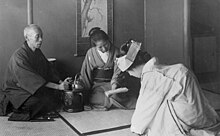This article has multiple issues. Please help improve it or discuss these issues on the talk page. (Learn how and when to remove these template messages)
|

Etiquette in Asia varies from country to country even though certain actions may seem to be common. No article on the rules of etiquette, nor any list of faux pas, can ever be complete. As the perception of behaviors and actions vary, intercultural competence is essential. A lack of knowledge about the customs and expectations of Asian people can make even those with good intentions seem rude, foolish, and disrespectful.
Asian etiquette is often manifested with shades of "respect", "good manners" and "filial", and is highly influenced by Chinese culture.[1][2][3]
- ^ "Asian Manners and Etiquette". www.pitlanemagazine.com.
- ^ Oster, Grant (6 April 2014). "Chinese Civilization's Impact on Japan and Korea". Hankering for History.
- ^ Merchant, Chad (14 November 2014). "Chinese Etiquette and How it Influences Business Dealings in Malaysia". ExpatGo.
© MMXXIII Rich X Search. We shall prevail. All rights reserved. Rich X Search
